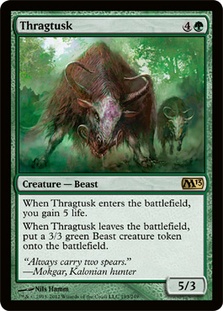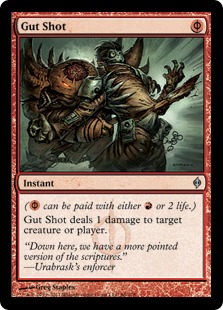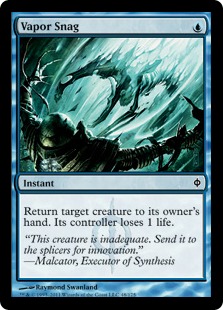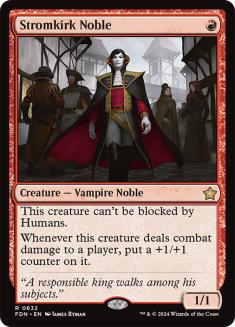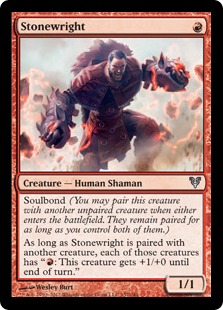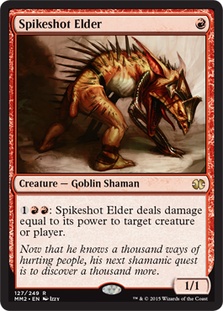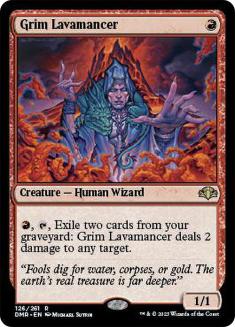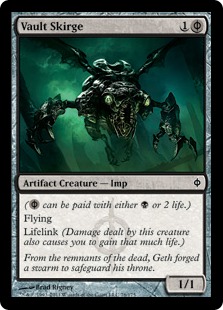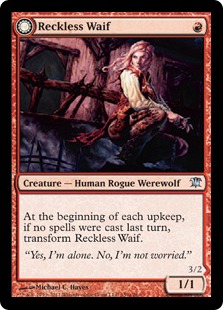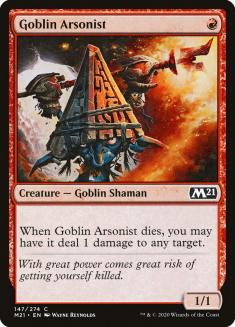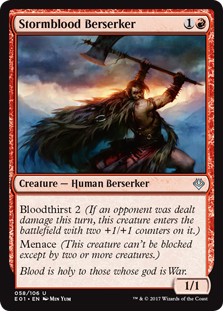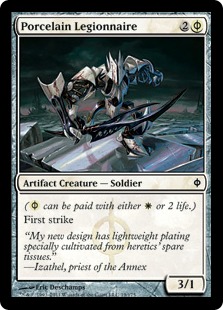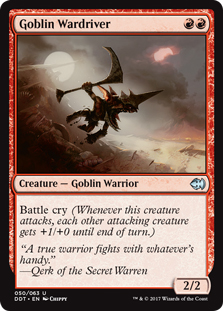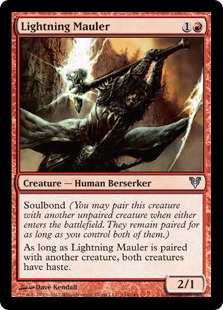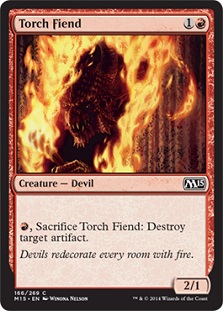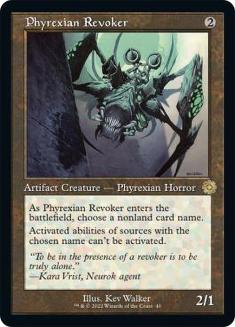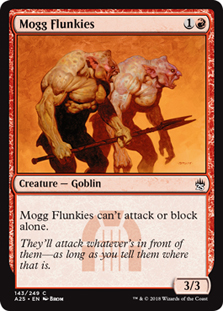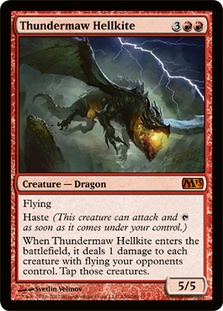There is a huge challenge right now in creating anything approaching a “classic” aggressive red deck. The issue is essentially a simple one: it is stuck in the battleground between superior forces. You come out in your tanks to do battle and find yourself in between Godzilla and King Ghidorah… Well, it ain’t pretty.
Delver, despite a moment where it has been out of the spotlight as of late, is still, in essence, the king of the hill. The de facto “new king of the hill” (whether it can actually beat Delver or not) are various varieties of green decks. For a red deck, fighting two of these enemies at once can be an incredibly challenging task, and that would be even in a universe where red had the same kind of weapons that it once had.
It used to be that if you were a red deck, you could really put someone on the ropes. It didn’t matter if it was with a Goblin Guide or a Figure of Destiny; you could really have someone in a rough spot from an early position, and even if you wouldn’t finish them with that first creature, you’d get in a respectable amount of damage so that you could wrap things up with your later game.
This is the real issue with a red deck right now: it can’t make you respect it early enough.
Oh, sure, it has some opens that are pretty saucy. You can drop a (weak) one-drop of some kind, and, if you hit, you can follow up with a Stormblood Berserker, and at this point, you’re looking at a pretty respectable clock. The real issue with the red deck is that it isn’t playing goldfish here; what it’s doing is fighting against a very particular pair of “villains,” and it lacks the raw power to really make either of those decks respond to it consistently enough.
So what it boils down to is this: if you are trying to play red right now, it really must be, for you, a labor of love. You’re the kind of person that either wants to give that red deck some flowers and chocolate or be the one getting the presents from the red deck. Either way, we’re talking romance, through and through.
Well, the reality is harsh: if winning the tournament is the path you’re looking for, you may have to wait for some new weapons to make this a reality. As Seth Burn, famous red mage extraordinaire, has said, the situation is that we “get a mixture of balanced and weak red cards.” Not exactly the stuff of dreams.
The Real Enemy
You might think that the enemy of red is this card:
If you say that, you’re wrong. Thragtusk, if that is your big concern, is beatable, powerful though it is.
Here is the real enemy:
Why are these cards the real enemy? It’s what they do to a red deck while a Delver deck makes mincemeat of them with Restoration Angel, Geist of Saint Traft, and/or Blade Splicer.
Mostly, though, it is all about the “balanced and weak” cards that red gets to run with in their quest to beat down.
What are your reasonable one-drops? (And this is if we stretch to be generous…)
In this metagame, I don’t even consider Reckless Waif and Goblin Arsonist playable (and yes, that is a Vault Skirge). And yet, red is so thin, I’m generously including them. So here you are with these one-drops, trying to establish some kind of meaningful attack phase, and every single creature that you put down on the table can be taken down by a Gut Shot.
Ugh.
Noble can survive, should it manage to connect. Even then, though, you’re stuck in the awkward position of having a single Vapor Snag reset the game to a point where the Noble is practically a non-card. Even worse, a lot of these decks sideboard Mental Misstep, which, while not actually there for you, is still effective.
Then the two-drops (again being generous):
Again, nearly none of these cards can survive a Gut Shot. Of those who can, a Vapor Snag is actually incredibly taxing, either resetting a Berserker or nullifying a Flunkies entirely. Only Goblin Wardriver isn’t terribly hurt by Vapor Snag, but Wardriver doesn’t really keep much in the way of company that is actually even scary at all, so this is no big deal.
Wardriver isn’t even alone in its desire for company. Clearly Flunkies likes to party in a group, but what good is Stormblood Berserker if you haven’t gotten in there with a creature first? Not much! And yet, to do so, you actually need to play all of those incredibly vulnerable one-drops.
This is a trap. A big one.
Hell, even after you get past this question of what kind of creatures are you going to put on the table, very quickly the next question becomes, “God, how do I get past their creatures?”
It’s a problem.
In an attempt to solve some of these problems, I worked on a different red deck, with mixed success.
What it boiled down to was, in three games, I could put up a fight against a Delver deck, but that many, many of the games came down to whether or not they had a timely Divine Offering for my Shrine of Burning Rage or my Sword of War and Peace. I was only running 22 lands (a lot for many red decks, to be fair), but this was few enough to choke on my artifacts sometimes.
And, worse, I was struggling a lot against the green decks. I’d tuned my deck to have a reasonable fight against Delver, but wow, was a green deck a problem, even in those games where they didn’t draw Thragtusk.
Beating Thragtusk
You’d think that beating a card like Thragtusk would be impossible for a red deck. This is definitely not the case, though. A card like Thragtusk, if that’s the only major target you’re trying to defeat, is very beatable. Tricksy-trickiness like Act of Aggression and Phyrexian Metamorph can let you directly answer a Thragtusk in a way that makes the Tusk quite blunted. A five-life chunk of lifegain can be a real problem for red, but only if you are playing red without the ability to take out huge hunks of life.
Another way to beat the Tusk is to make sure that they can’t cast it easily. Typically, this involves the Dan Paskins‘ game “All Elves Must Die” (first usefully detailed in his article, Ha Ha, Dead Elf). The idea: kill all the mana dorks.
You’d be surprised how often this stops a five-drop being able to come into play before they die. Of course, a lot of times, it still does, and then you have to deal with a Tusk.
So how do you beat Thragtusk? You make sure that your deck is capable of taking out huge chunks of life. This is very doable if you chose to play the right cards. If you want to do more, you play those actively anti-Thragtusk cards in your board.
Certainly, you’re not pumping the fist if your opponent casts one. And you may be weeping if they cast another or Restoration Angel it. But a single Thragtusk is not all she wrote.
Big chunks of damage are the key, particularly evasive big damage. And this is where the “new kid on the block” for red comes in.
The New Kid on the Block
So far, Thundermaw Hellkite feels real to me. Damn real. A lot real.
Beacon of Destruction is a card that definitely saw some play in its day. I certainly brewed more than one deck with it, and when the card first saw print, it was a cornerstone of one of the major red decks of its day. That card was real. Hell, Josh Ravitz made Top 8 of US Nationals with a Flores deck featuring the card.
Thundermaw Hellkite is more real.
As has already been said, Thundermaw Hellkite compares favorably to Inferno Titan in terms of damage—by turn 7, when an Inferno Titan may have attacked for the first time, we’re talking twelve damage plus whatever pumps are in the mix. In the same time, Thundermaw Hellkite has attacked for fifteen. This is a huge amount of damage.
Beacon had the ability to potentially kill a huge creature. I know that I used it on many occasions to do that very thing. But it goes away. Thundermaw requires an answer or it just Lava Axes again and again and again and, oh, wait, you’re dead.
When I first played with Thundermaw, it was in a perhaps overly ambitious Goblins list which is very, very far from ready for prime time. With not enough lands to really support the Thundermaw (and not enough room to cut spells for lands), it felt powerful but not quite impressive.
That was when old school Chicagoan Ronny Serio showed me the way with an aggressive red list that ran 26 land. His original list was very close to the shell of a 22-land red list I had been working on, but he somehow found some room for cards that were not in my build: the new lands from M13 and Thundermaw.
Suddenly, it felt like there was hope.
Wow. There were so many moments where I was “flooded” with the 26-land build, and yet I felt as though I always had things to do. My Thundermaws were always managing to hit play. I was able to play Bonfire and just wreck house with it, despite not having access to mana dorks of my own. I was able to mulligan more aggressively.
As Ronny and I went back and forth working on the deck, one thing became clear: Delver was still a problem.
The big issue was the Gut Shot / Vapor Snag package against the potential clock of a Geist. You could actually have a lot of game, but if they dropped a Geist, they could just barely kill you in time. Something needed to be done.
MRA (Midrange Red Aggro)
This deck is basically an ongoing collaboration of ideas from Ronny and I, both playtesting separately and talking about the deck as time passes. There was also certainly some inspiration from former semi-pro Adam Jansen, another one of the Red Burn Cadre from Chicago.
Here is where I am, as of today:
Creatures (24)
- 2 Molten-Tail Masticore
- 2 Spikeshot Elder
- 3 Phyrexian Metamorph
- 2 Chandra's Phoenix
- 4 Stormblood Berserker
- 4 Stromkirk Noble
- 4 Stonewright
- 3 Thundermaw Hellkite
Lands (12)
Spells (24)
Sideboard

There are some pretty unusual choices that I think require some discussion.
Cathedral of War and Hellion Crucible:Â I actually feel like this is some of the glue holding the deck together, particularly Cathedral of War. Ultimately, you end up having the Cathedral make each and every single one of your creatures into a more potent threat. This is particularly a big deal when you get multiple Cathedral and you have some form of evasion or if you get a Spikeshot Elder going. Hellion Crucible, in the same vein, gives you some extra value out of having the extra mana but doesn’t constantly demand anything of you; if you have the time and the inclination, you can turn an extra land into a 4/4. And if you don’t want to pull the trigger, you don’t have to.
Stonewright: I wasn’t a true believer when I first saw the card. Time has passed, though, and this card is just awesome. I can’t tell you how many times Stonewright just acted like a Fireball casting monsters. All it takes is something with evasion or an empty table. Even if you have a non-red source making the Stonewright a little bit weaker, he is still worth it. At certain points, you get to a level of mana where a topdecked Spikeshot in conjunction with this guy will immediately end the game, and there is nothing wrong with simply throwing him away to kill an Angel.
Spikeshot Elder: I mention him a little bit, above, but right now, Spikeshot is just a real winner. Aside from the ways in which the natural pumping of your other permanents can do a lot of work in making Spikeshot approach “absurd,” you can also make him go crazy with Mutagenic Growth. When you’re playing with 26 land, this can make him scary indeed!
Molten-Core Masticore: I’d forgotten all about this little guy until I saw him in the Top 8 of a Magic Online  PTQ. Suddenly, it all came rushing back: my memories of Masticore in the earlier rotation of red decks and just how insane he could be. One of the big weaknesses of red decks right now is the ways in which the creatures can easily be outclassed as a game progresses. Molten-Core Masticore takes that concept and throws it to the curb, turning each and every one of your creatures you draw into a potential Fireblast. Right now is Masticore’s time for red. There is also something particularly special about Masticore in this deck, where you have creatures that are very potent early but get anemic and you can get into board states that are gummed up; Masticore deals with both sides of this coin.
Phyrexian Metamorph: This is a simple nod to three creatures in particular (though it can also help against Restoration Angel): Geist of Saint Traft, Thragtusk, and Blade Splicer. Keeping up with the Joneses can sometimes require special effort. Metamorph is that effort.
Bonfire of the Damned: Simply put, this card is just amazing. This is one of the defining cards from Avacyn Restored, and one of the best cards in Standard right now, period. Running 26 mana, it seems crazy not to put all four in this deck, particularly because it is a more aggressive deck.
Mutagenic Growth: From time-to-time, this card sneaks into red lists. Right now, I think, is one of those times. Gut Shot is so ubiquitous, and combat math does seem to be at a premium with Restoration Angel making Growth into a potential surprise kill spell. Normally I don’t like this card in red, but I think right now it is a necessary evil.
Most of the other cards will make a lot of sense to people. But some notable absences are worth mentioning.
Shrine of Burning Rage: I love Shrine. I think it is one of the reasons to play red. Unfortunately, it is a card that ends up making you into the kind of red deck that I don’t think you’re going to have success being. There will absolutely be games in which a Shrine would have been the best play possible on turn 2. And then there will be games in which it just is too slow, clogs you up, and just makes you wish you had some actual action affecting game play. Right now with Birthing Pod, G/R Aggro, and Delver, this happens far more often than I’d like, so I ended up cutting these cards for some more active cards.
More burn: While it was painful to cut Arc Trail from the main and sad to not have any Incinerate style burn, the simple fact of the matter is that you need to be capable of doing a hell of a lot more damage in chunks. You can board in the Arc Trail (or mainboard it in the more Bird-heavy metas), but you really just need to be establishing a presence in Standard right now.
The sideboard is certainly worth some minor discussion. Koth of the Hammer is your go-to anti-control card, giving you another angle of attack. Four Combust, while a lot, is an important part of your sideboarded game against Angels and Insects. If you feel this is overkill, cut one for another card of your choosing. Ancient Grudge and Smelt are there together to punish artifacts and also to strongly disincentivize a player from going into a Sword plan—if you go with all Smelt, you can cut the green mana from the deck. Zealous Conscripts is against the various “Big Play” decks, like Elesh Norn style decks. Act of Aggression is valuable against Thragtusk, but it’s also just a solid card in creature wars. Arc Trail is there for the Elf/Bird decks.
Overall, I’m really quite happy with this list, and it seems, in initial testing, to be holding its own. It still isn’t the deck I would play if a gun were pointed at my head, but in online queues, I feel good that it, like its pre-M13 precursor, is a solid deck to pick up wins with and get my red fix. (And, man, do I get that need for a good red deck sometimes.)
You can expect to see me looking to pick up some Thundermaw Hellkite ASAP online—I already have my set on paper.
Until next week,
Special Bonus Section
Here is another red deck that I’ve been working on for a while. Enjoy:
Creatures (12)
Lands (9)
Spells (39)
- 14 Mountain
- 1 Island
- 4 Galvanic Blast
- 4 Sphere of the Suns
- 2 Slagstorm
- 4 Pristine Talisman
- 3 Batterskull
- 4 Bonfire of the Damned
- 3 Trading Post
Sideboard

I have been playing a variant of this deck for a while. I hope you enjoy it.

